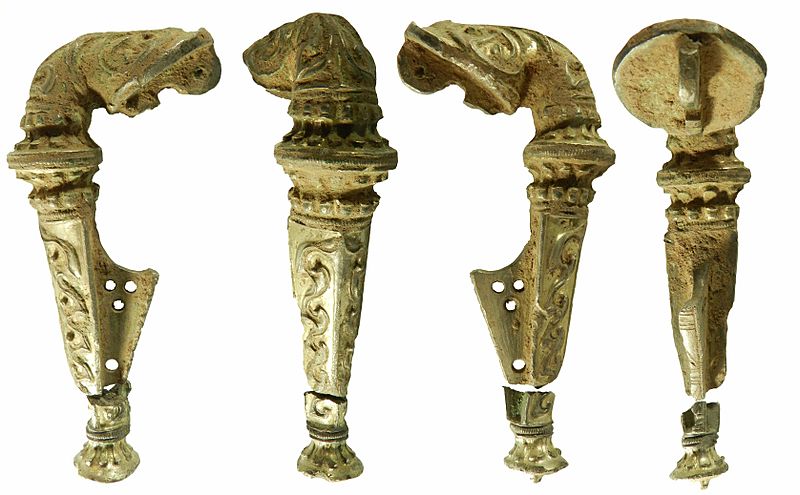Image: Roman trumpet brooch (FindID 508627)

Description: Large silver-gilt trumpet brooch of Mackreth's Trumpet brooch sub-type 1.2c1 with petalled knop. Head is slightly hollow with R-shaped attachment for spring. Elaborate scroll pattern on head (two large open scrolls with complex moulding inside; separated by two trumpet like mouldings; the central moulding then curls back on itself into two tight scrolls above the central petalled knop, the lower bow in triangular in section and has two curvilinear relief-moulded designs resembling stylised waves, with projecting points, and diminishing in size toward the foot. The lower bow (recently broken and detached) has a knurled double moulding above the petalled foot, which terminates in a circular boss, with a central projection. The pin and head loop are missing. The catchplate has four perforations, three in a triangular formation towards the top and a single perforation towards the bottom. The outer edge of the catchplate is decorated with incised lines forming two elongated rectangular panels with internal oblique lines). A petalled rosette mount with a central boss, silver gilt, originally attached to the now missing head loop, is almost certainly from this brooch. The rear of the rosette is broken but two small round channels can be seen which held the headloop. Detached examples have been found at Wroxeter and Bourton on the Water (Boon 1978). Parcel-gilt, where the background is gilt leaving the silver scroll work to stand out in relief. Weight before cleaning: main brooch 84.2g, broken foot 6.2g; detached rosette 3.1g (total 93.5 g, but cleaning to remove soil will reduce this by several grams). Width at head: 25mm; Length (without headloop) 89mm. The seperate rosette consists of eleven thin petals surrounding a small conical boss, separated from it by a shallow moulded ring. The petals are spaced evenly with reserved spaces between them. The whole design is mounted on a circular base, 4.4mm thick with a concave edge and 4 moulded ridges around the circumference. Attached underneath the base is a thick, perpendicular cuboid fitting with two perforations and a concave lower edge decorated with mouldings. Two fragments of wire found with the rosette were probably originally threaded through the perforations, now no longer attached. The upper surface and sides of the base are gilded. Rosette: Weigh before cleaning: 5.0g; Diameter: 11.6mm; Height: 10.3mm Wires: Combined weight before cleaning: 0.5g; Diameter: 1.7-2.0mm A very close parallel can be seen in the brooch from the nearby Church Minshull, Cheshire hoard (Abdy et al. 2004). This is a very large brooch estimated at between 80 and 90mm long but it was deliberately broken and is incomplete. The head decoration is very similar to the Knutsford area example (latter requires cleaning). The smaller Carmarthen brooch (Boon and Savory 1975) represents another strong parallel. The petalled type of trumpet brooch is strongly western and northern in distribution (Mackreth 2011, 120). Mackreth lists examples from Wroxeter 2 and Church Stretton, while another comes from the Church Minshull hoard, Cheshire. The closest parallels in type are also geographically close, Shropshire and Cheshire (both Cornovian tribal territory) with the Carmarthen brooch from S Wales at a greater distance (Boon and Savory 1975). The Knutsford area find is considerably larger than the Carmarthen example (89mm long compared to 63mm for the main brooch, minus headloop; the Carmarthen example weighs 49.5g with the headloop but lacks the pin; the Knutsford area example weighs around 90g. There is little doubt that the two exceptionally large brooches from the Knutsford area and Church Minshull hoards were manufactured by the same workshop or craftsman (and possibly even the same mould?). A fragment of another very large example published by Mackreth (2011, 120), from the Baths Basilica at Wroxeter might be from the same mould or workshop. Allowing for a lifespan of a couple of decades, the hoard deposition dates, possibly within a decade either side of 180, suggest the brooches were manufactured in the period AD 150-170. The wearing of linked brooches was a female fashion (cf. Chorley, Lancashire two silver trumpet brooches linked by a chain found with coins from Galba to Hadrian) (Boon and Savory 1975, 45).
Title: Roman trumpet brooch
Credit: https://finds.org.uk/database/ajax/download/id/389691 Catalog: https://finds.org.uk/database/images/image/id/389691/recordtype/artefacts Artefact: https://finds.org.uk/database/artefacts/record/id/508627
Author: National Museums Liverpool , Vanessa Oakden, 2012-07-25 11:14:10
Permission: Attribution-ShareAlike License version 4.0 (verified 28 November 2020)
Usage Terms: Creative Commons Attribution-Share Alike 4.0
License: CC BY-SA 4.0
License Link: https://creativecommons.org/licenses/by-sa/4.0
Attribution Required?: Yes
Image usage
The following page links to this image:

